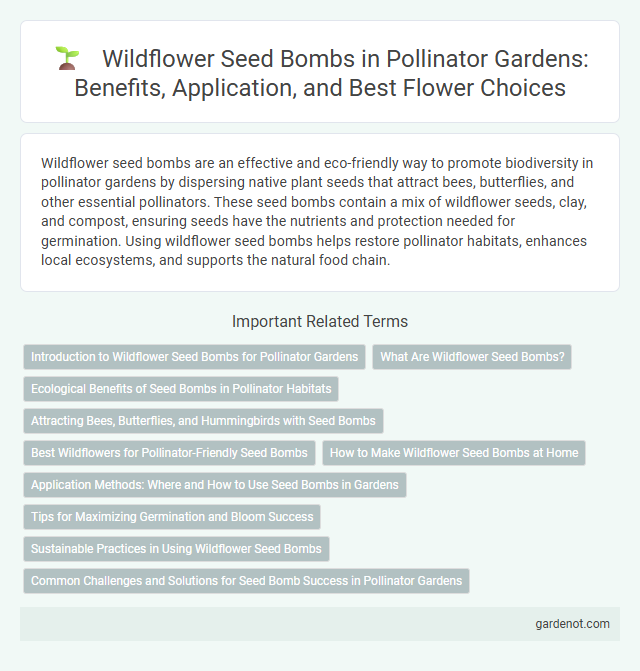Wildflower seed bombs are an effective and eco-friendly way to promote biodiversity in pollinator gardens by dispersing native plant seeds that attract bees, butterflies, and other essential pollinators. These seed bombs contain a mix of wildflower seeds, clay, and compost, ensuring seeds have the nutrients and protection needed for germination. Using wildflower seed bombs helps restore pollinator habitats, enhances local ecosystems, and supports the natural food chain.
Introduction to Wildflower Seed Bombs for Pollinator Gardens
Wildflower seed bombs are compact balls made from a mixture of native wildflower seeds, clay, and compost designed to effortlessly introduce diverse pollinator-friendly plants into gardens. These seed bombs support bees, butterflies, and other pollinators by promoting vibrant, nectar-rich habitats that enhance biodiversity and ecosystem health. Their easy deployment makes them an effective tool for gardeners seeking to boost pollinator populations while beautifying outdoor spaces.
What Are Wildflower Seed Bombs?
Wildflower seed bombs are compact balls made from a mixture of fertile soil, clay, and a variety of wildflower seeds specifically chosen to attract and support pollinators such as bees and butterflies. These eco-friendly seed bombs can be scattered in urban or degraded environments to promote biodiversity by enabling wildflowers to flourish naturally without the need for extensive gardening effort. Designed for easy dispersal, wildflower seed bombs help create vibrant pollinator gardens that enhance local ecosystems and improve pollination rates essential for plant reproduction.
Ecological Benefits of Seed Bombs in Pollinator Habitats
Wildflower seed bombs play a crucial role in enhancing pollinator habitats by promoting biodiversity and supporting native plant growth, which provides essential nectar and pollen sources for bees, butterflies, and other pollinators. These seed bombs help restore degraded lands quickly and sustainably, improving soil health and increasing habitat connectivity. Incorporating seed bombs into pollinator gardens boosts ecological resilience and fosters a thriving ecosystem vital for pollinator survival.
Attracting Bees, Butterflies, and Hummingbirds with Seed Bombs
Wildflower seed bombs are an effective tool for attracting bees, butterflies, and hummingbirds by providing a diverse array of native flowers rich in nectar and pollen. These seed bombs contain a mix of wildflower seeds specifically selected to bloom at different times, ensuring a continuous food source for pollinators throughout the growing season. Deploying seed bombs in a pollinator garden enhances biodiversity, supports declining pollinator populations, and promotes a healthy ecosystem.
Best Wildflowers for Pollinator-Friendly Seed Bombs
Purple coneflower, black-eyed Susan, and bee balm are the best wildflowers for pollinator-friendly seed bombs due to their high nectar and pollen production. These native species support a wide variety of pollinators including bees, butterflies, and hummingbirds, enhancing garden biodiversity. Their robust growth and adaptability ensure successful establishment in diverse soil conditions, making them ideal for seed bomb projects.
How to Make Wildflower Seed Bombs at Home
Creating wildflower seed bombs at home involves mixing wildflower seeds with a combination of clay powder and compost to form small, compact balls. These seed bombs can be dried for 24-48 hours and then scattered in pollinator garden spaces to promote native plant growth and support bees and butterflies. Using this eco-friendly method enhances pollinator habitats while requiring minimal effort and resources.
Application Methods: Where and How to Use Seed Bombs in Gardens
Wildflower seed bombs are ideal for revitalizing bare soil patches in pollinator gardens, roadside verges, and neglected urban spaces, providing a habitat-rich boost for bees and butterflies. To use, simply scatter the seed bombs evenly over prepared soil or lightly roughened ground during the early spring or fall when moisture levels support optimal germination. Avoid compacted or heavily shaded areas to ensure the wildflower seeds within the bombs receive adequate sunlight and water for successful growth.
Tips for Maximizing Germination and Bloom Success
To maximize germination and bloom success of wildflower seed bombs, ensure planting in early spring or fall for optimal soil temperatures between 50-70degF (10-21degC). Choose well-drained, nutrient-poor soil and lightly press the seed bomb into the soil surface without covering it completely to allow sunlight exposure. Regularly water the area, keeping the soil moist but not waterlogged, to support steady seedling growth and vibrant wildflower blooms.
Sustainable Practices in Using Wildflower Seed Bombs
Wildflower seed bombs promote sustainable practices by enhancing local biodiversity and supporting pollinator populations such as bees and butterflies. Using native wildflower species in seed bombs reduces the need for chemical fertilizers and pesticides, preserving soil health and ecosystem balance. These seed bombs enable low-impact planting in degraded or hard-to-reach areas, fostering natural habitats and contributing to ecological restoration.
Common Challenges and Solutions for Seed Bomb Success in Pollinator Gardens
Wildflower seed bombs often face challenges such as poor germination due to dry or compacted soil and predation by birds or insects. To improve seed bomb success in pollinator gardens, use a mix of native wildflower seeds suited to local climate, apply seed bombs in early spring or fall, and create a lightly disturbed soil bed to enhance seed-to-soil contact. Incorporating biodegradable binders like clay and compost helps retain moisture and nutrients, promoting healthy seedling growth and increasing pollinator habitat support.
Wildflower seed bomb Infographic

 gardenot.com
gardenot.com